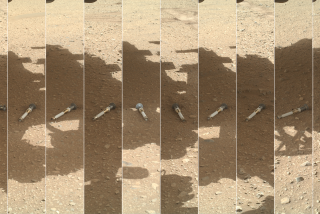NASA Will Launch Robot to Seek Water on Mars
NASA plans to launch a $300-million roving robot to Mars in 2003 to search for the water that many researchers suspect flows just beneath the surface of the arid planet, space agency officials announced Thursday.
In a sharp departure from its recent practice, the Jet Propulsion Laboratory will build the Mars spacecraft on its own in Pasadena, not in partnership with Lockheed Martin Space Systems Co. in Littleton, Colo., which built several Mars probes that failed last year.
NASA officials are still mulling whether to launch a second $150-million robot rover mission to Mars in 2003.
“We are evaluating the implications of a two-rover option,” said Edward Weiler, NASA’s associate administrator of the Office of Space Science in Washington, D.C. “I intend to make a decision in the next few weeks so that, if the decision is to proceed with two rovers, we can meet the development schedule for a 2003 launch.”
The rolling robot will be dropped to the surface of Mars in a cocoon of airbags, using a landing system that proved its worth during the 1997 Mars Pathfinder mission--the most successful U.S. Mars mission since the Viking landings of the 1970s. Mission planners abandoned the more complex rocket-powered landing system that caused the Mars Polar Lander to crash last year.
NASA’s new Mars rover will be almost 10 times larger than the Sojourner robot that landed with Pathfinder and will carry five instruments to study the surface of the Red Planet during its 90-day mission, JPL officials said Thursday. It could travel as much as a half mile from its landing site.
“This one will rove as much in one day as Sojourner roved in its entire 90-day mission,” said JPL Mars program manager Firouz Naderi. “In essence this is a robotic geologist.”
If all stays on schedule, the mission will be launched in late May of 2003 on a Delta II rocket and reach Mars on Jan. 20, 2004, after a journey of more than seven months. When it enters the Martian atmosphere, an international flotilla of at least four other spacecraft also will be orbiting the Red Planet.
The exact landing site has not yet been chosen, but is likely to be a place where scientists believe there was once water, such as a former lake bed or channel deposit.
NASA’s plans for exploring Mars got a setback when the $165-million Mars Polar Lander, the Deep Space 2 probe and the $125-million Mars Orbiter all failed when they reached the planet last year.
More to Read
Sign up for Essential California
The most important California stories and recommendations in your inbox every morning.
You may occasionally receive promotional content from the Los Angeles Times.










